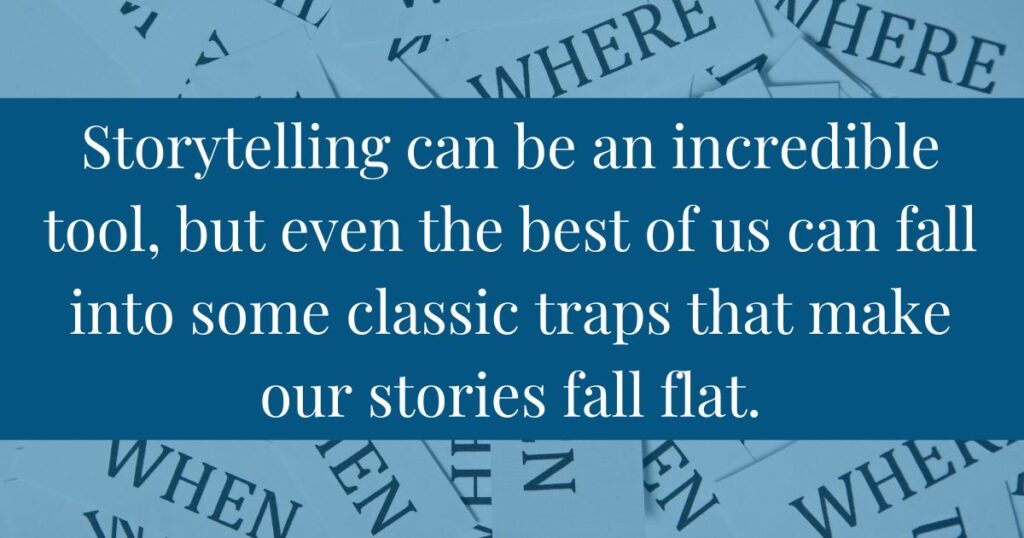
You’re telling a story. Maybe it’s in a post. Maybe it’s on stage. Maybe it’s in a room where winning someone over actually matters.
You think you’ve got them. But when you finish, there’s no shift in the air. No spark. No reaction at all. Just a few polite nods, a lukewarm “Wow, that’s inspiring,” or—worse—nothing.
And that’s when it hits you: They didn’t feel a damn thing.
Not because your story wasn’t important. Not because it wasn’t true. But because you told it in a way that made it too easy to ignore, skim, or forget.
A good story sticks. It lingers. It changes something in the listener. A forgettable story dissolves on impact. It might be interesting in the moment, but a day later? Gone. No impression. No shift. Just another piece of content, lost in the abyss.
And if that’s happening to your stories, it’s not because your ideas aren’t good enough—it’s because you’re making one of three mistakes that flatten your storytelling.
Let’s fix them.
Storytelling Mistake #1: Your Story Is a Blurry Mess
Ever sat through storytelling that should be gripping but somehow feels like it’s being told through a fog machine? That’s what happens when you keep things broad. You think you’re making it universal, but really, you’re making it weightless. Easy to tune out. Easy to forget.
“I struggled a lot.” With what? Managing your money? Managing your time? Managing to get out of bed?
“It took years to figure things out.” What things? The mechanics of your craft? How to sell? How to convince yourself you weren’t a fraud?
A story without specifics has no focal point, no detail, nothing for the brain to hold onto. But a good story drops you into the moment. Instead of saying, “I was struggling in my business,” say, “I had a whole system for bouncing payments just right—knowing exactly which charges would slide through, which ones would get rejected, and how long I had before the overdraft hammer actually dropped.” Instead of “I was terrified of failure,” say, “I refreshed my email every three minutes, dreading another ‘Thanks, but no thanks’ rejection.”
Details are what turn words into scenes. If your story is a blur, your reader’s attention is already gone.
Storytelling Mistake #2: You’re Presenting the Facts. Nobody Cares.
No one connects with a story that reads like a police report. And yet, so many people tell stories like they’re afraid to take up too much space—like if they just lay out the events in a logical order, the audience will connect the dots on their own.
They won’t.
That’s your job.
“I left my corporate job to start my own thing. At first, it was a struggle, but eventually, I found my footing.”
Sure. That’s a summary. But it’s not a story. But what if you shifted your focus from ‘what happened’ to how you experienced those events?:
“The night before I quit my job, I sat in my car for 45 minutes, staring at the email draft on my phone—one line typed, deleted, retyped. My stomach was a fist. My thumb hovered over ‘Send.’ I knew that once I pressed it, there was no undoing it. No walking it back. No safety net.
I hit send.
And immediately wished I hadn’t.”
One version tells me what happened. The other makes me go “oh shit.” That’s the difference between a forgettable story and one that pulls people in.
If your story doesn’t hit your reader somewhere in the feels, it’s not a story—it’s a status update.
Storytelling Mistake #3: You’re Talking, But Not To Anyone.
Even a well-told story will flop if it’s told to the wrong people. Or, worse, to no one in particular. It’s the storytelling equivalent of delivering a TED Talk to an empty room—words are coming out, but no one’s actually there to hear them. If your audience doesn’t feel like a story is for them, they will mentally categorize it as “someone else’s experience” and move on.
A great story isn’t just about you. It’s about the person reading it. And if you don’t give them a way to see themselves inside of it, they will check out. SO, before you even start writing, ask yourself: Who is this for? What do they care about? Where does my story overlap with their experience?
If you’re talking to freelancers, tell them about the time you undercharged so hard you made 47 cents per hour. If you’re talking to burned-out professionals, tell them about the moment you realized you couldn’t answer one more email without screaming. If you’re talking to creatives, tell them about the time you stared at a blank page for so long you started questioning your entire career. The moment your audience sees themselves in your story, they stop consuming it and start feeling it. And that’s when it actually matters.
So, let’s call it what it is.
If your stories aren’t landing, it’s not because people don’t care. It’s not because they’re too distracted, too busy, or too whatever excuse makes it easier to swallow. It’s because you’re giving them an easy out. You’re making them work to see the point. You’re handing them something they can skim, nod at, and forget five minutes later.
A good story doesn’t allow for that. A good story demands to be felt.
It doesn’t just “share an experience.” It builds a trapdoor—one step looks solid, but the moment they hit it, they’re in. Caught. Dropped into something they weren’t expecting to care about but suddenly do.
Because now it’s theirs, too.
And that’s the goal. Not just to be read, but to be absorbed. Not just to be heard, but to be held onto.
So if your stories aren’t hitting, rewrite them. Sharpen them. Make them undeniable.
Because the only thing worse than telling a bad story?
Telling one that disappears.
comments +